What happens when you fall into, and out of, love? We get to the bottom of the cuddle hormone oxytocin and find out if the contraceptive pill is good for relationships. And we navigate our way around a fruit flies brain to find out how pheromones make them in the mating mood. Plus, we'll explore if it's scientifically possible, and even ethical, to bring on love in humans.
In this episode

What Does Love Mean?
We posed this question to Dr Alex Kogan, Cambridge University. Here's what he said!
Alex - Love is the best stuff in your life and worst stuff in your life. Love is a conundrum, a major question that has puzzled humanity for a long, long time. Love come and goes. Love can take many forms. It's one of the most broadly used words that I could imagine because we love everything from our parents, to our romantic partners, to cheese cake. It's extremely difficult to define, but it's something that really vibrates in all of our lives and it's probably one of the strongest motivators in our lives.
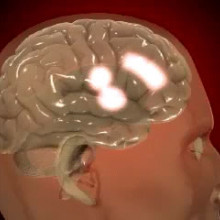
Whats Happens in the Brains During Love?
We posed this question to Dr Alex Kogan, Cambridge University. Here's what he said!
Alex - To be honest, we're still trying to figure that out. The neuroscience of love is very much in its infancy. We've had some studies come out that have suggested that when we feel love, there'll be award and motivation aspects of our brain light up. We do know that the dopamine system is involved within love. So, for example, when we show people pictures of their loved ones, the midbrain lights up and that's part of the reward system. And dopamine is one of the neurotransmitters that we have in the body, related to a whole host of processes, but it's part of the reward circuit so, feeling good about things when (there's something ever worth) to us. But to be honest, this work is extremely preliminary, still really trying to figure it out, and it's not a surprise. Love is one of the most complex states that we could be in. And so, to figure out what's going on in the brain is extremely difficult. Is it just neurotransmitters? Is it something with your body? Is it something more? These are still very much open questions that are really exciting to figure out.

Can You Make Someone Fall in Love With You?
We posed this question to Dr Alex Kogan, Cambridge University. Audio answer available here and transcipt will be on the site shortly.
Alex - The tricks of neuroscience, I'm not so sure, but if you want to make somebody fall in love with you, be nice to them. If you want to make somebody stay in love with you, be nice to them. You don't need to resort to pharmacology and other tricks like that. All that really isn't anywhere near has worked out as a simple, age-old sentiments of what's a good partner, what makes a good relationship. I would focus mostly on that, to be honest.
Hannah - So, in terms of the things that you can buy over the internet, so for example, Amazon I think sells pheromones, and you can also buy oxytocin sprays.
Aleks - Oxytocin is a neuropeptide in the sense that it can work both as neurotransmitter, so talking between synapses, but also as a hormone, so talking between different parts of the body. They're extremely ancient. So, we believe that they've been around for at least 700 million years. We find them in a whole host of animals and they're involved in many processes related to pair bonding, maternal care-giving, lactation, giving birth, potentially mate guarding. And so, there's this idea that it might be one of the things is really important for falling in love, keeping as monogamous and related processes. We're starting to discover all these negative effects of oxytocin. So for example, in recent studies, they've shown that when people get oxytocin administered intranasally, they could actually feel more envy and be more gloating than people that don't. We've shown in other studies that when for certain people who are very anxious about their emotional attachments, oxytocin makes them worse. They start to remember people more negatively. So, it really depends on the person and if you're a person that things that you really need the oxytocin to help you out, you might actually be a person that might have the most negative consequences for.
I'd be very, very careful with these pharmacological solutions. It's a young science we're really struggling to only probe, will last for 10 or 20 years, the side effects for humans and it's a long way to go.

Why do I Love the Smell of My Children?
We posed this question to Dr Alex Kogan, Cambridge University. Here's his answer!
Alex - Well, smells can be very much reinforced through learning patterns where you smell your children and you love your children, and we could pretty much pair those two stimuli together. There might be something also in terms of chemicals going on with pheromones and other transmitters, but it's probably an open question at this point, how much they're involved, how much of this is just a basic learning process.

06:16 - Can You Enhance Love?
Can You Enhance Love?
with Professor Julian Savulescu, Oxford University
Hannah - I wanted to continue to explore the potential of chemicals, such as oxytocin, to stimulate love, pairing it with the question are humans meant for monogamy? And can we promote happy long term relationships using new knowledge from neuroscience?
Love potions have been used throughout history in the hope of bringing on, and maintaining, love. In Swedish folklore, to capture the heart strings of someone you might pop an apple under your armpit carry it about for a day, and then bequest it as a pressie to your intended lover. And even since Roman times various foods have been prescribed to stimulate lust, love and good relationships.
and maintaining, love. In Swedish folklore, to capture the heart strings of someone you might pop an apple under your armpit carry it about for a day, and then bequest it as a pressie to your intended lover. And even since Roman times various foods have been prescribed to stimulate lust, love and good relationships.
While such examples may have been based on symbolism and wishful thinking, as Alex mentioned, today the biological underpinnings of love are now starting to be elucidated.
At the same time trends in divorce, suggest that love might need a helping hand. Should science interfere? I called up an Oxford don to explore this topic further.
Julian - My name is Julian Savulescu. I'm the Uehiro Professor of Practical Ethics at the University of Oxford.
I think it's important to understand that human beings are animals and that the most highly coded biological, phenomenon is reproduction. That's what enables every animal to survive, so it's not surprising that love has a very strong biological determinant influences. That's not to say it's a purely biological phenomenon, but we shouldn't forget that aspect of our nature that we share in common with other animals, and understand its limitations.
Human beings are in part monogamous. They're serially monogamous. People tended to stay in relationships for between 7 to 10 years where through most of human history, one partner would've died. In human beings, it's also complicated by the fact that men have a genetic drive to be polygamous outside of their main relationship. So, it's far easier for them to pass on their genes to the next generation through a number of women where women have a strong drive to have the investment of a single mile. So, they're competing biological drives.
Hannah - And say, you're in a monogamous relationship, is there any tricks that we can use from neuroscience in order to kind of stay within that happy bubble of a relationship for the long term?
Julian - So, all relationships have three phases: The first phase of lust, the second phase of attraction, fully in love with the particular person for their particular characteristics, and then the much longer phase of attachment where human beings stay together in order to rear their young. It's the biological function of attachment. And attachment is what, they say, tends to fade with time and it's sustained by neural hormones such as oxytocin or vasopressin. So, changes in the level of those neural hormones can affect the degree to which people are attached and stay attached. So, oxytocin is released through sexual intercourse. So, regular sexual intercourse would be a relationship bonding event as well as just touching or massage, or indeed some drugs such as some formulations like the old contraceptive pill. So, in the future, it may be possible to strategically affect these neural hormones that are involved and underpin those different phases of human relationships.
Hannah - Can we go back to the contraceptive pill and its effect on attachment? Can you give us some more details on that please?
Julian - Some versions of the old contraceptive pill are associated with some elevations in oxytocin. It's not clear whether these have an actual real world of fix, but theoretically, they could and theoretically, you could enhance the oxytocin that they think affects various hormones.
Hannah - And do you think it is ethical or do you think it would be right to deliver any of these oxytocin releasing chemicals in order to help relationships stay together? Do you think that's a question that we're going to have to look into in the future?
Julian - Human beings have inherent biological limitations and in many ways, they weren't designed for the world in which they do live in and the sort of world they want to live in. And science is showing these ways in which we can overcome those inherent biological obstacles and I believe we should use that knowledge to achieve the worthwhile goals that we have. Just changing some of the biology by itself won't bring about any good outcome. You need to couple that with some environmental social intervention. But to deny people access to these sorts of options is really to kind of make them rather race with one hand tied behind their back.
Hannah - And what about the fact that there's emerging information, talking about how oxytocin can have some negative impacts as well - possibly, feelings of envy and smugness?
Julian - Oxytocin can promote in-group solidarity, but make people negative towards out-groups. So, it has a variety of effects. So, at the moment, the science of understanding our emotions and our behaviour is still in its infancy, but I think that as we get finely grained understanding of that, we will be able to make better and more specific uses of that information. So for example, some psychologists have started to use oxytocin, not as a general love drug or relationship promoter, but in order to help couples open up during counselling session and be more willing to engage in the counselling process. So, I think what you will find is that whatever biological intervention is available will have to be tailored to specific social circumstances and that's going to be a challenge, but that's the case for anything - a blood pressure lowering agent can be good in most people, but bad in some circumstances and bad for some people.
Hannah - That was Professor Julian Savulescu from Oxford University, exploring modern-day potions for love.
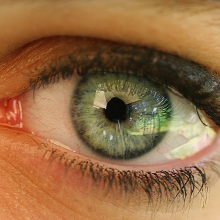
Is Love a Drug?
Hannah - Earlier Alex mentioned another brain chemical involved in love - dopamine. We know that dopamine, as well as being involved in reward is very frequently involved in addiction. So, if love brings on a rush of dopamine to particular areas of the brain, is it possible successful long term relationships may be down to people simply being addicted to each other?
Well, a study by Bianca Acevedo and colleagues in 2012 showed that people who, after 21 years of marriage, and still very very happily in love, when shown pictures of their other halves had areas of the brain lighting up in a pattern resembling drug addiction.
So, it really could be that those that stay in love are just addicted to one another! Romantic, in some sense, I suppose.

14:07 - Peering into the Brain with Prism Lenses
Peering into the Brain with Prism Lenses
David - It's been a busy month. Last week I was at the 57th Annual Meeting of the Biophysical Society over in Philadelphia, and heard about some great advances in neuroscience. The first news item I'd like to talk about this week was from a presentation at this conference by Michael Levene, over at Yale University. Using some cutting edge optical techniques Dr Levene and his colleagues have been able to image the brains of mice in real time using tiny lenses called micro-prisms.
Hannah - So they are using small lenses to magnify looking into live brain as it does its job. How are they doing this exactly?
David - The group are able to surgically implant these tiny prisms into the  brains of living mice, causing only very slight damage to the brain. They can then shine a laser through this prism and visualise the brain in real time and record from these mice for months.
brains of living mice, causing only very slight damage to the brain. They can then shine a laser through this prism and visualise the brain in real time and record from these mice for months.
Hannah - Wow. So you can image the brain of a living mouse. What else have the group managed to do with this technology?
David - Well one of the most remarkable things they are doing is using the prisms to visualise the layers of the cerebral cortex, a technique that has previously required taking slices of the brain. Using the micro-prism, the scientists can shine their laser microscope beam so that it runs perpendicular to the surface of the brain, giving us an insight into how brain cells in the cortex interact with one another.
Hannah - So is this looking deep into the brain? Why is this area so important to study?
David - Well in living mice we can see how the cells in different layers of the cortex interact with one another during activities like running or sleeping. This gives us a real picture of what the brain looks like on a cellular level, while its working!
Hannah - This technique sounds amazing. Look forwards to hearing more about what they find out with it.

15:55 - Scratching Away at the Sensation of Itch
Scratching Away at the Sensation of Itch
David - My next news item has to do with the mystery of itching.
Hannah - Itching?
David - Yes itching. So scientists have long been baffled by the physiology of itching. It's been very hard to pin down whether itch is communicated to the brain by the same nerves that signal pain or whether they signal through their own individual nerves.
Hannah - So it was thought before that when I feel itchy, that's because the same nerves in by body that respond to pain are being activated? Well, yes I can imagine, itching is kind of painful, but it feel very different to typical pain.
David - Yes so, previous research had shown that capsaicin, the spicy chemical in chillis, activates a set of neurons that are also activated by itchy chemicals. This led to the belief that itchy sensations must be somehow linked to painful sensations through these same nerves. But new evidence from researchers at John Hopkins University have identified a subset of itch-specific neurons.
Hannah - So these newly identified nerve cells signal to the brain the sensation of itch. How did the scientists find this out?
David - The researchers used sophisticated molecular biology to identify neurons that responded to itchy chemicals, like histamine or the anti-malarial drug chloroquine. They then showed that these neurons could also be activated by the spicy capsaicin chemical, but that this sensation, instead of being perceived as pain, by mice, was actually perceived as an itching sensation. These data indicated that there are a subset of neurons that signal itch to the brain when both itchy and fiery chemicals are around.
Hannah - So now that these itchy neurons have been identified, what can researchers do with this finding?
David - Well excessive itchy sensation can be a very unpleasant effect  from conditions such as dermatitis and although these neurons might not be responsible for conveying all aspects of the itchy sensation, if we can design drugs that target them, we may be able to reduce the discomfort felt by patients.
from conditions such as dermatitis and although these neurons might not be responsible for conveying all aspects of the itchy sensation, if we can design drugs that target them, we may be able to reduce the discomfort felt by patients.
Hannah - We might be able to scratch away at that itch without scratching using this info!
17:57 - Love Chemical for Species Survival
Love Chemical for Species Survival
David - My last paper this month ties into the Valentine's day themes of love and sex with some findings from a collaborative paper from German and American researchers about the evolution of sex pheromones, the chemicals released by organisms wanting to attract a mate. Now while the effectiveness of human pheromones has long been debated by scientists, the value of pheromones in other animals is clear. Males release chemicals that specifically attract females of the appropriate species. This signal attracts coupling between compatible animals.
Hannah - A fascinating system for attraction, but how did this system evolve to produce coupling between specific species?
David - That is the exact question that the authors of this paper,  published online in Nature this month, aimed to work out. They studied the pheromones produced by members of the parasitic wasp genus Nasonia. What they found was that the Nasonia vitripennis wasp produces a novel pheromone, different from other pheromones produced by other species.
published online in Nature this month, aimed to work out. They studied the pheromones produced by members of the parasitic wasp genus Nasonia. What they found was that the Nasonia vitripennis wasp produces a novel pheromone, different from other pheromones produced by other species.
Hannah - So this wasp species produces a pheromone different from other species. What did the researchers do with this information?
David - They were able to show that the new pheromone was intitially ignored by potential mates if it was presented alone. If however the new pheromone was mixed with a blend of the old pheromones, the female wasps became responsive to the new signal. They used wasps from a sister species, Nasonia giraulti, to show that this effect was specific to the Nasonia vitripennis wasps.
Hannah - So if the pheromone was ignored by these wasps, how did it eventually become detected and why is that important, in evolutionary terms?
David - Well the data indicate that while a new pheromone is initially ignored by its intended recipient, evolutionary mechanisms will eventually develop a new olfactory receptor for the female wasps. This gives the new wasps a way of detecting their potential mates in a more specific way, making it more likely that they will mate with the right type of wasp.
Hannah - Ever evolving love, beautiful!
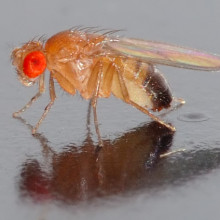
20:18 - Learning about Courtship from Flies
Learning about Courtship from Flies
with Dr Greg Jefferis, MRC Laboratory of Molecular Biology, Cambridge
I wanted to find out more about these pheromones that David mentioned. And so, join Dr. Greg Jefferis from the Medical Research Council Laboratory of Molecular Biological in Cambridge. He's been looking not at wasps, but another flying insect - the fruit fly.
Greg - So, you might wonder why would we study flies. Well, my lab is interested in how the brain works. I think a lot of us are interested in how the brain works. In particular, we're interested in how individual neurons within the brain talk to each other in order to allow them to process information about the outside world and control behaviour. Now, we'd love to study these processes in the human brain, but at least for me, the human brain is too complicated. There are about 100 billion neurons in the human brain, so that's the nerve cells in the brain that are communicating with each other. So, even a mouse has 100 million neurons and that still is too complicated for me at least. So, we study the fly. The fly has 100,000 nerve cells and for me, this is a countable number and someday, maybe in the not-too-distant future, we might be able to understand how all of these neurons are connected to each other and what they're talking about when the fly is behaving.
Hannah - Greg and his lab are looking at how nerve cells connect in relation to one specific type of behaviour - courtship. So, typically, the male fly will approach the female fly by following her around. He'll sing her a love song - essentially, serenading her then he'll try to lick and touch her and eventually, try to copulate with her. She will respond to these courtship attempts by either becoming docile and letting the male do his thing or if she's not impressed by his attempts, she will just kick the male in the face literally.
What's controlling this behaviour? Well, one key regulator is a chemical signal, a so-called pheromone called cVA. cVA is given off by the male fly and when other males smell this other pheromone, it increases their aggressiveness; sometimes they will even get up on their hind legs and boxing each other. Whereas usually, females increase their receptivity when they smell this chemical signal, and Greg is looking at how the nerve cells involved in cVA detection connect and make a circuit to give rise to these different behaviours as he explains.
Greg - So, what's really nice is that here, we have the same molecule that can trigger different behaviours in male and female flies. And so, what we'd like to know then is, why is this? What we did was, we recorded from nerve cells inside male and female flies while we were puffing pheromone onto them. So, to do this, we mobilise the fly, we make a very small hole in its very small head. The neurons that we're interested in have been made to glow green, so that we can tell them from all the other neurons in the fly brain. We then approached those neurons with a very fine glass electrode and we see along to a single cell, and record its activity.
Hannah - So that's some really neat technologies that you're combining 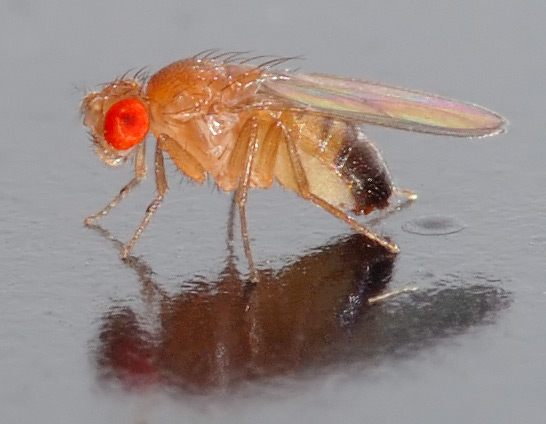 there and I'm presuming that this is in the fully conscious living fly?
there and I'm presuming that this is in the fully conscious living fly?
Greg - That's right. So, the fly is alive and kicking, and it's responding to these smells that we're puffing onto it. It is pretty amazing when you're doing the experiment, when you look at the activity on these individual electrodes, you're sitting there, watching the fly think.
Hannah - So, Greg measures the electrical activity of nerve cells in the fly as it's being puffed with pheromone. It turns out that the pheromone cVA is detected by the fly's antennae. Here, there's the olfactory organ of the fly - the smell region and this activates the first nerve cell in the circuit. This nerve cell then talks to a second nerve cell and the second nerve cell passes that electrical activity onto the third nerve cell that's deeper in the fly brain, and that's the basic circuitry for pheromone perception. It's a really simple 3-nerve cell circuit and the key difference in this circuit between the male and female fly is at that third deepest nerve cell level which Greg calls neurons A or B.
Greg - We've been able to show that A neurons are connected to the incoming pheromone information in males but not females, and B neurons are connected to that information in females but not males. So really, you've got a very simple setup here. You have a clear difference in wiring, in connectivity that's resulting in a difference in their response of particular neurons in male and female brains.
Hannah - Gosh! That's exciting! So, do you know what's controlling this switch, this circuitry which neurons are going to be connected?
Greg - We certainly are excited. It's the first time that anybody has been able to demonstrate a sort of bidirectional switch like this in any animal as far as we're aware. Now, in terms of what's controlling it, one of the nice things about the fly system is that we have a really good idea about that. So, there's a particular gene called fruitless is a transcription factor that means it controls other genes. This fruitless gene is actually only active males. So, the action of fruitless in males is to rewire the A and B neurons. So, what you can imagine is that fruitless unplugs the B neurons and it plugs in the A neurons. Normally in females, the default wiring pattern is that the B neurons will be plugged in and A neurons will not.
H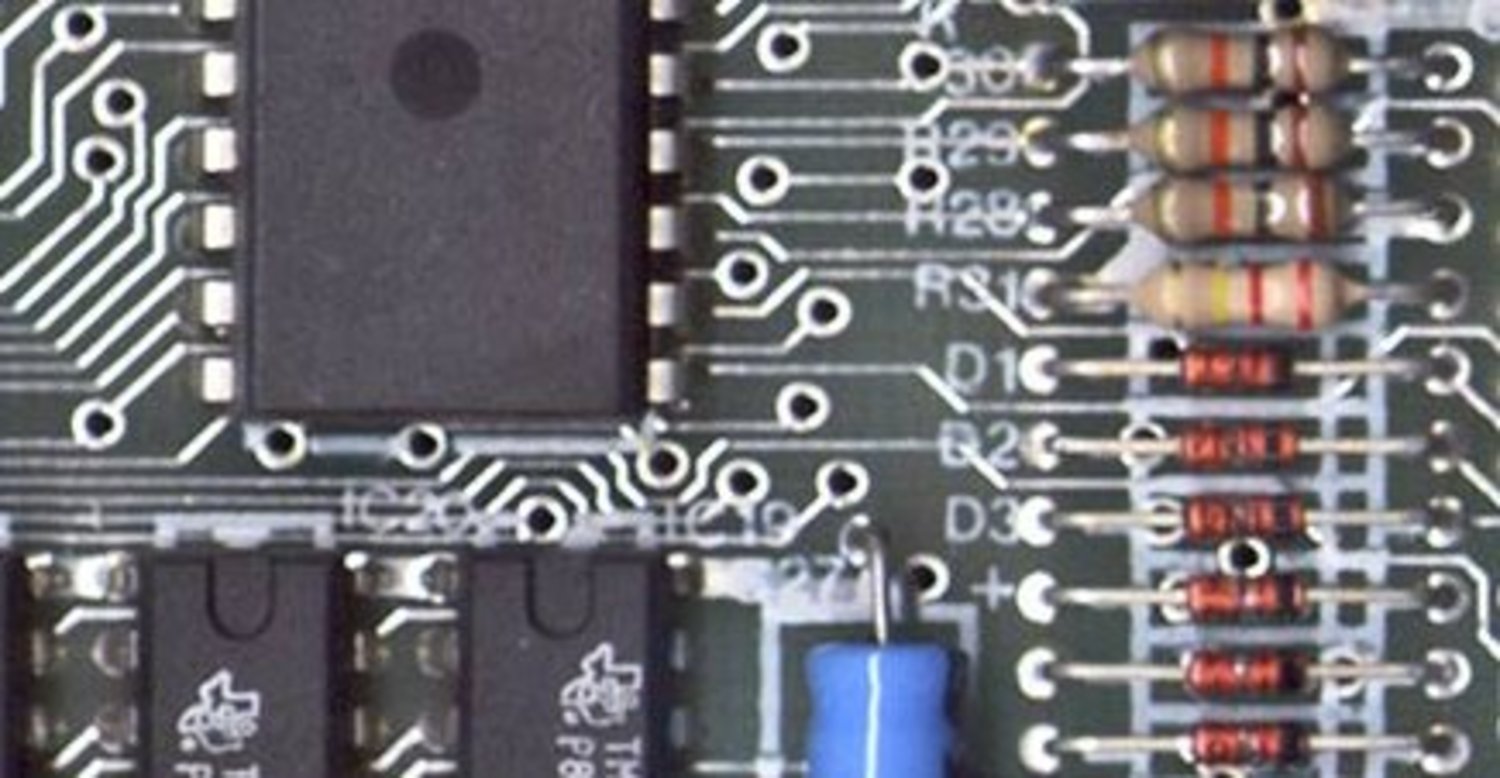 annah - So, if you take the analogy of a train on rail tracks, imagine the pheromone signal cVA is the train and the rail tracks are the cables with which the nerve cells and the circuit communicates. In both sexes, the train on the rail tracks goes past the first station - so the first nerve cell on the antenna. The cVA train goes past the second nerve cell deeper in the brain, and then at the level of the third nerve cell, something different happens. Here, the train can either go to station A to the right or station B to the left. So, in the female flies, the train will turn left and go to one part of the fly's brain and in male flies, the train will go to the right, and this controls mating behaviour. Greg and his lab have found this out and also, that the simple circuit switch directing the train route is controlled by the gene fruitless.
annah - So, if you take the analogy of a train on rail tracks, imagine the pheromone signal cVA is the train and the rail tracks are the cables with which the nerve cells and the circuit communicates. In both sexes, the train on the rail tracks goes past the first station - so the first nerve cell on the antenna. The cVA train goes past the second nerve cell deeper in the brain, and then at the level of the third nerve cell, something different happens. Here, the train can either go to station A to the right or station B to the left. So, in the female flies, the train will turn left and go to one part of the fly's brain and in male flies, the train will go to the right, and this controls mating behaviour. Greg and his lab have found this out and also, that the simple circuit switch directing the train route is controlled by the gene fruitless.
Greg - What we've even been able to show is that the action of this gene only needs to be restricted to the A or the B neurons, and the rest of the brain doesn't need the action of this gene in order to flip this switch.
Hannah - So, does that mean then that you can express fruitless in female baby flies and then change their behaviour so that they become male courting aggressive flies?
Greg - So, we haven't done that experiment, but somebody else has, Barry Dickson's lab in Vienna, and that's exactly what they found. So, they caused fruitless to be expressed in the male pattern in female flies, all the way through development. And the result of that was female flies that will actually try and mate with other females. And what we think we found is this little switch in olfactory processing is one of the changes that is required to turn a female brain into a male brain and produce these kinds of behavioural differences.
Hannah - So, that was Dr. Greg Jefferis from Cambridge, discussing how a switch within a simple 3-circuit system switches on mating mode in male and female flies. I also asked Greg whether such pheromones and such a switch may exist in humans. He emphasised that human brain is very, very complex and it's hard to study these kinds of questions in humans at the moment. We don't have a clear answer, but he's not about to start buying pheromones that are being sold over the internet just yet.

28:01 - Experience, Perception and Emotion
Experience, Perception and Emotion
with Professor Cori Bargmann, New York
Now we finish off with something else that has been keeping a neuroscientist up all night, her wonder and amazement at how our brain computes information to give us our perception of the world.
Cori - Hi. I'm Cori Bargmann from the Rockefeller University in the Howard Hughes Medical Institute in New York in the USA.
 One of the things that amazes about the brain is that every day, your brain encounters a different situation that you've never seen before, and maybe has never been seen before by anyone in the world, and yet, your brain can make sense of it. There are infinitely many worlds and your brain takes all of those worlds and turns them into a logical, coherent series of events. We don't know how to teach a computer how to interpret every possible event that could ever arise in the world. You can even imagine writing a computer programme that would programme in every situation, every combination of people, every combination of the weather, and the place, and the car, and the situation you find yourself in. And yet, your brain solves that problem effortlessly and turns it into a constant and sensible perception of the world.
One of the things that amazes about the brain is that every day, your brain encounters a different situation that you've never seen before, and maybe has never been seen before by anyone in the world, and yet, your brain can make sense of it. There are infinitely many worlds and your brain takes all of those worlds and turns them into a logical, coherent series of events. We don't know how to teach a computer how to interpret every possible event that could ever arise in the world. You can even imagine writing a computer programme that would programme in every situation, every combination of people, every combination of the weather, and the place, and the car, and the situation you find yourself in. And yet, your brain solves that problem effortlessly and turns it into a constant and sensible perception of the world.
So, I'm really interested in understanding how the brain can interpret infinitely many environments and generate infinitely many perceptions and emotions, and thoughts and behaviours. And that's why I'm a neuroscientist and I study the brain.
Hannah - That was Professor Cori Bargmann from Howard Hughes Medical Institute, New York, describing how all at infinite colliding situations perception and emotions.










Comments
Add a comment